Charles E W Bean, Diaries, AWM38 3DRL 606/243B/1 - 1916 - 1926 - Part 8
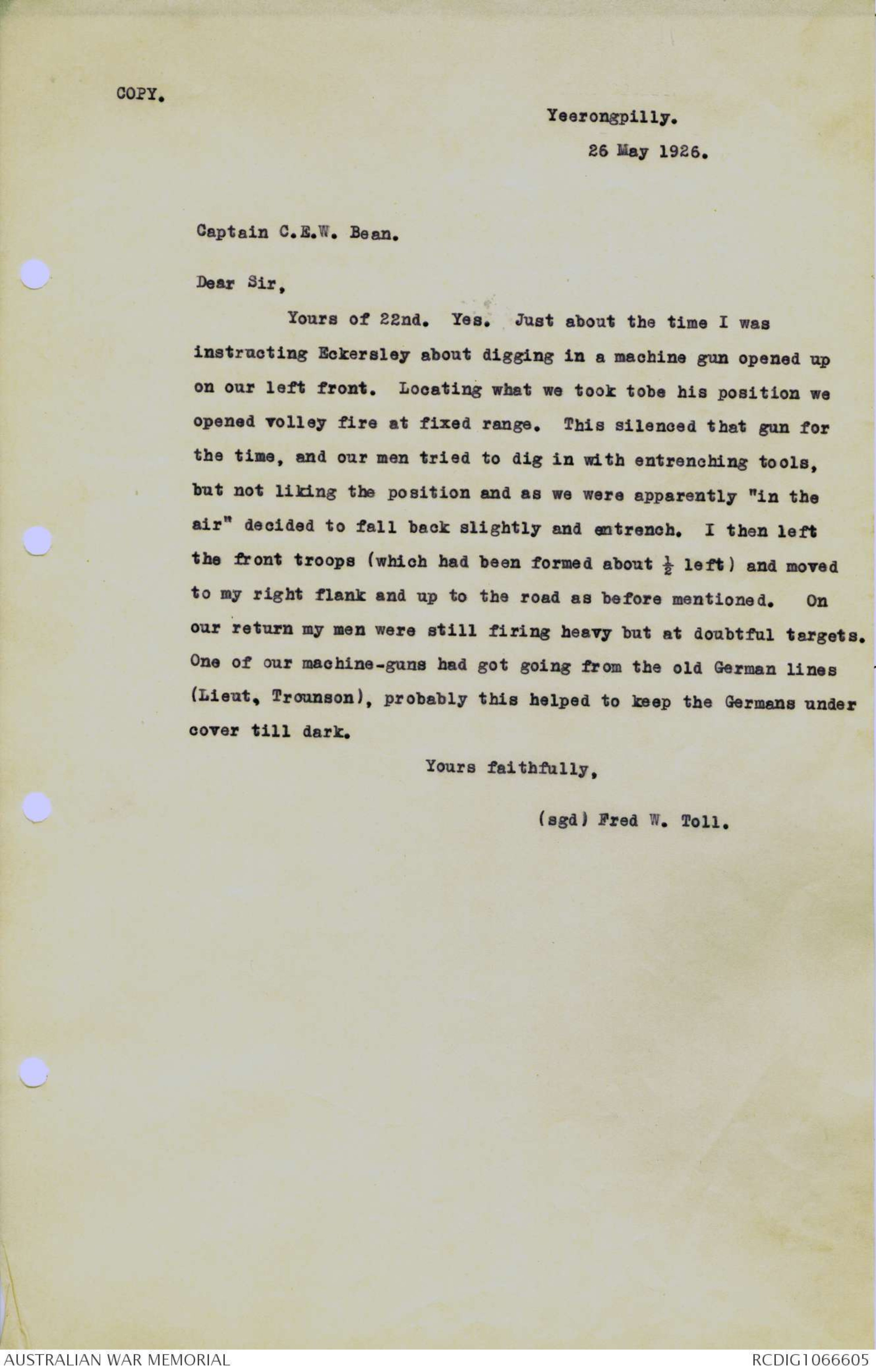


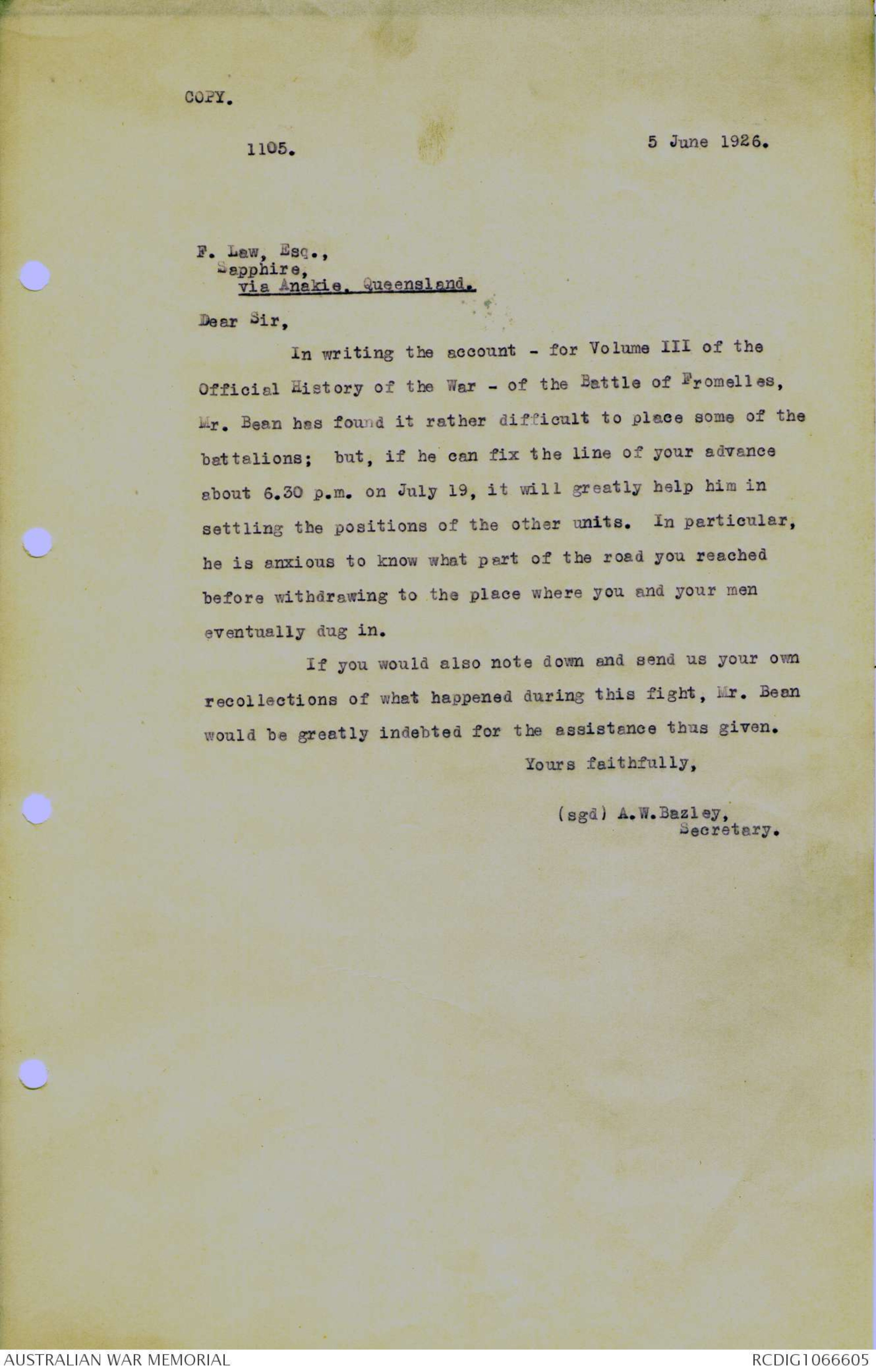
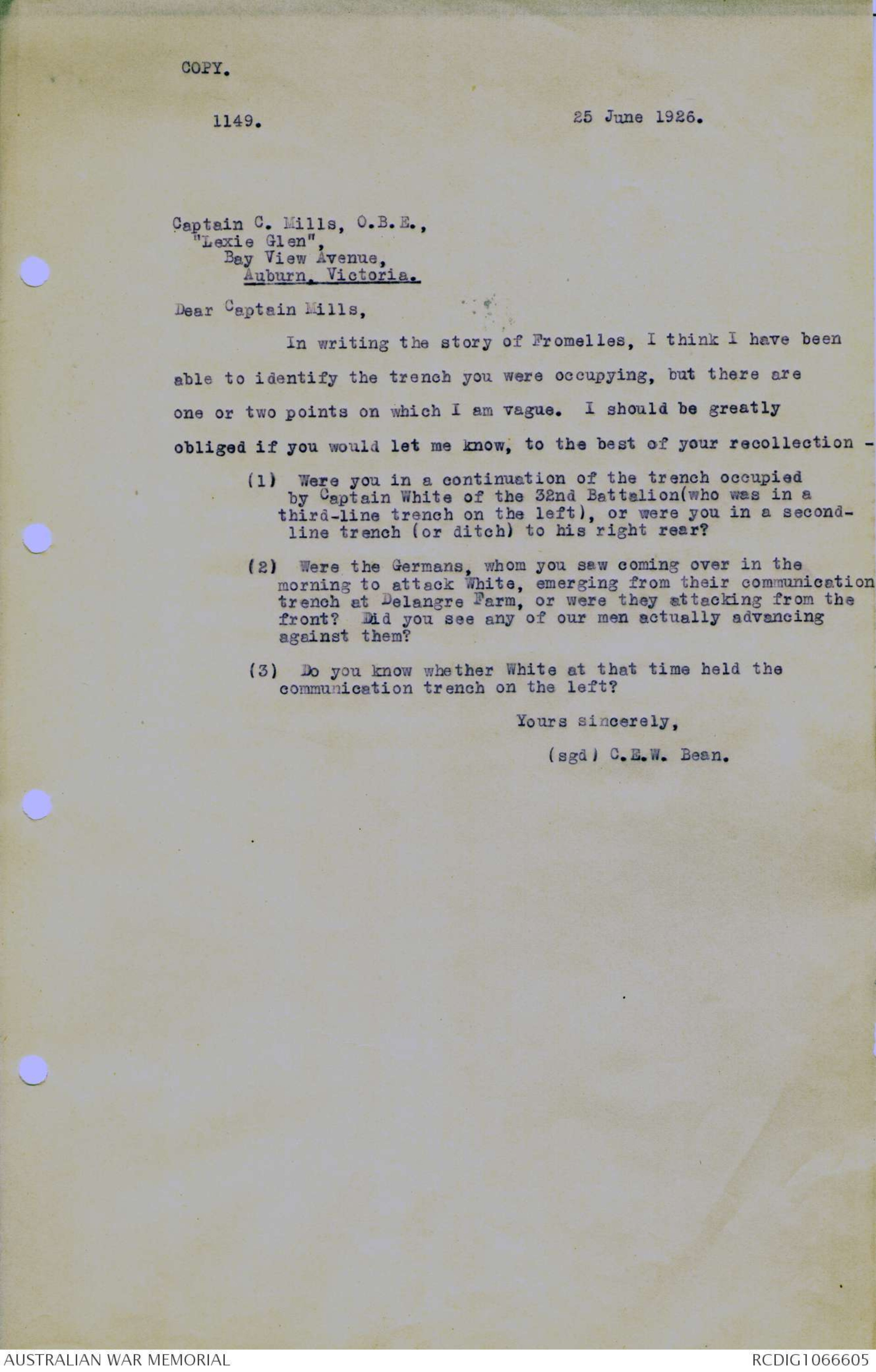
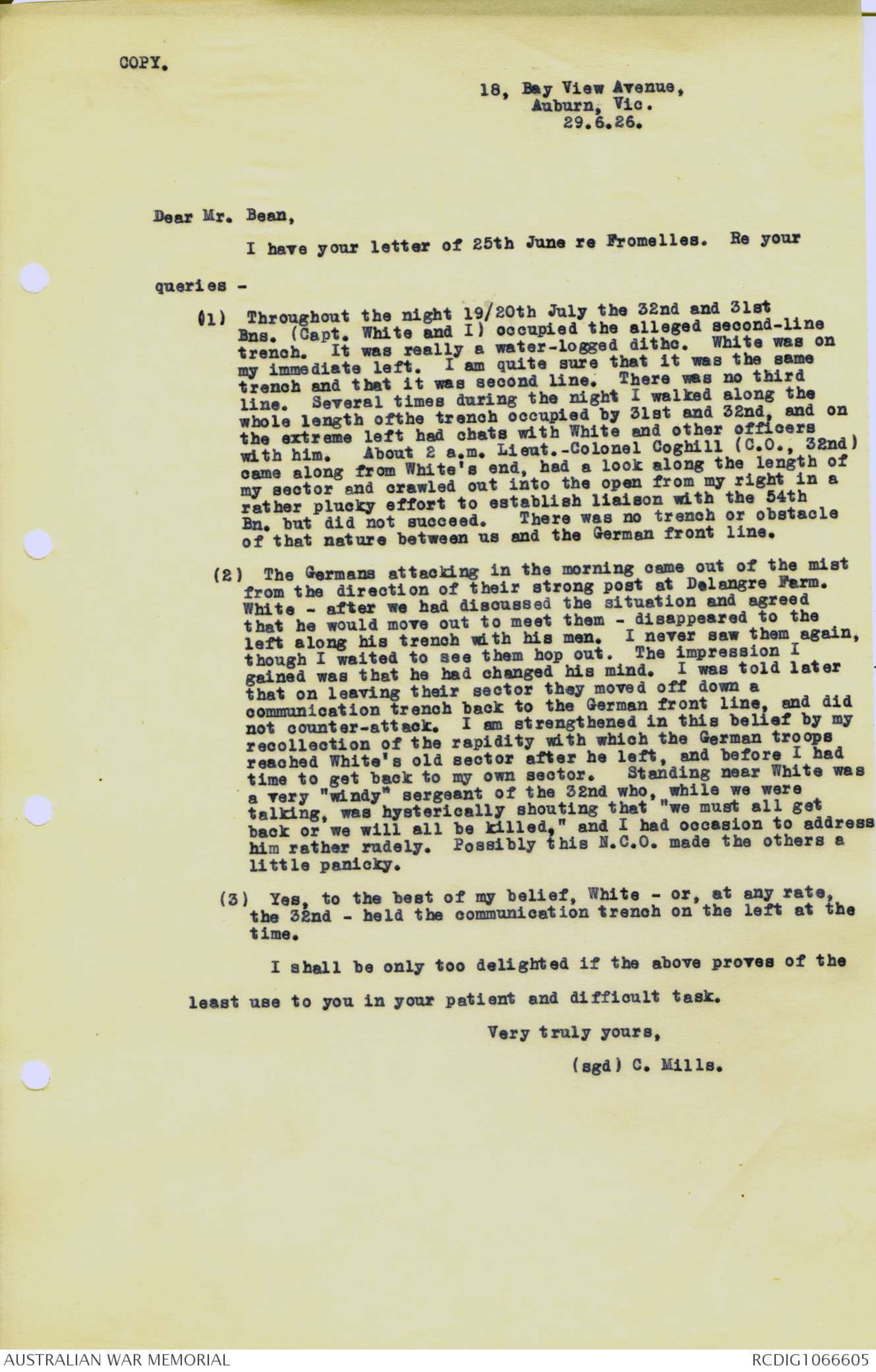
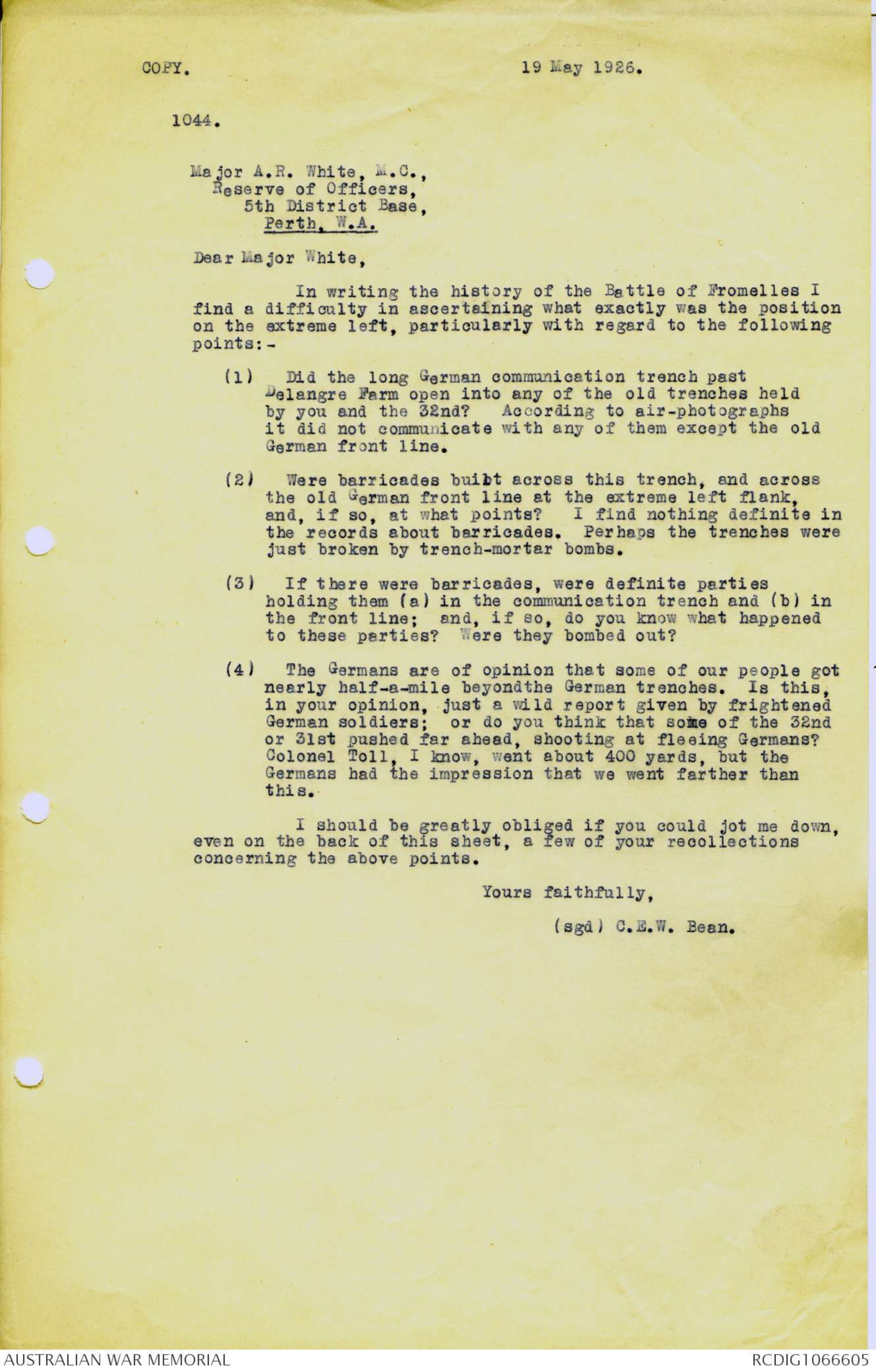


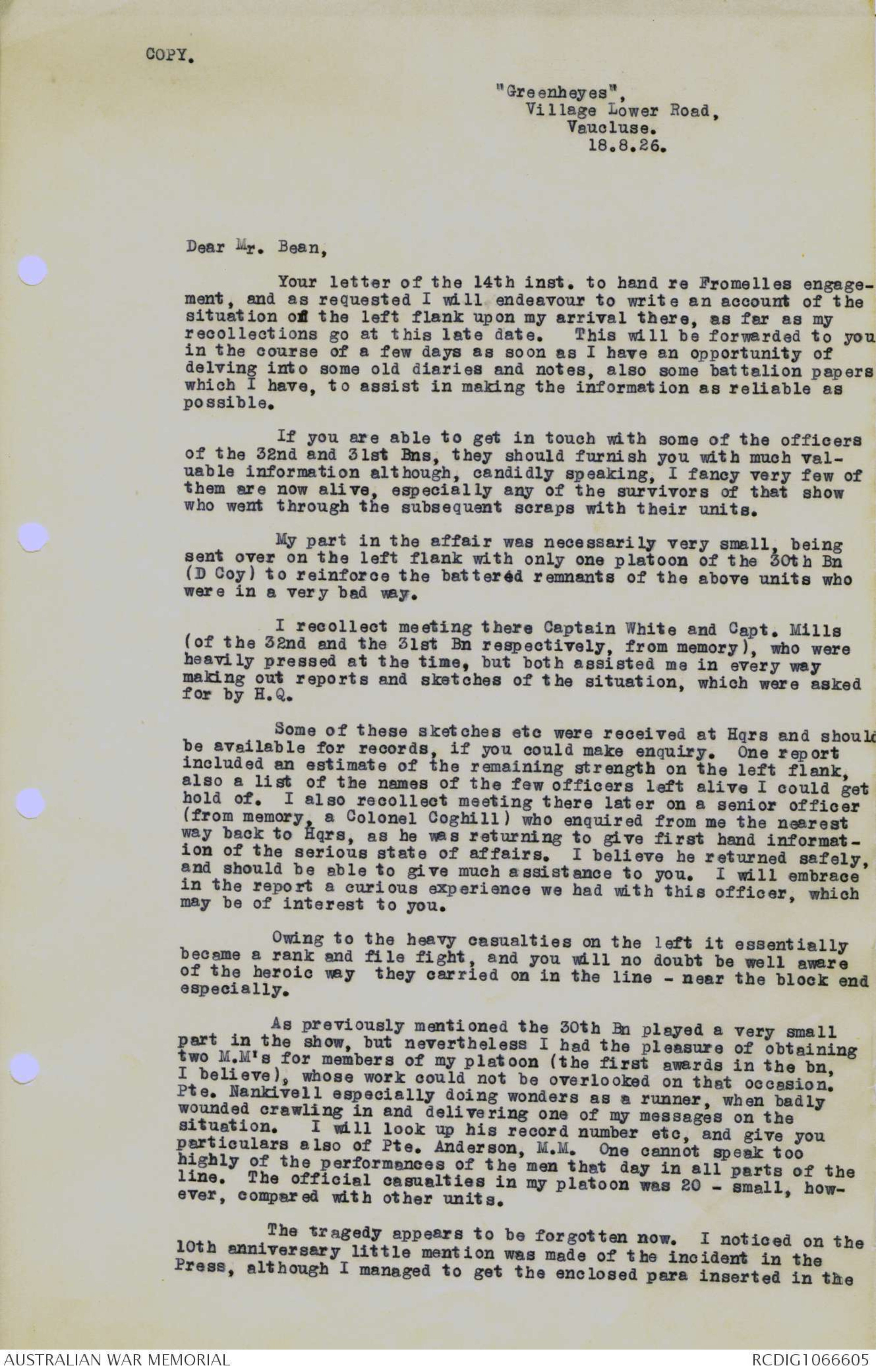
COPY.
Yeerongpilly.
26 May 1926.
Captain C.E.W. Bean.
Dear Sir,
Yours of 22nd. Yes. Just about the time I was
instructing Eckersley about digging in a machine gun opened up
on our left front. Locating what we took tobe his position we
opened volley fire at fixed range. This silenced that gun for
the time, and our men tried to dig in with entrenching tools,
but not liking the position and as we were apparently "in the
air" decided to fall back slightly and entrench. I then left
the front troops (which had been formed about ½ left) and moved
to my right flank and up to the road as before mentioned. On
our return my men were still firing heavy but at doubtful targets.
One of our machine-guns had got going from the old German lines
(Lieut, Trounson), probably this helped to keep the Germans under
cover till dark.
Yours faithfully,
(sgd) Fred W. Toll
COPY.
1197. 5 July 1926.
Lieutenant-Colonel F.W. Toll, D.S.O., V.D.
Dear Toll,
In writing the chapters dealing with Fromelles I have
been a little puzzled by your order, given about 7 or 7.30, to
withdraw to the front line. As reported, it appeared to be an
order for the whole of the 31st to take position in the German
front line as no other defence line had been found, and this, I
think, was the construction probably put upon it by Brigade H.Q.
At the same time Mills and Eckersley do not seem to have acted
upon it, but to have remained in such trenches or ditches as they
could find, digging in. Can you remember whether the order
reached them all, or how it was that the discrepancy occurred.
Your messages to Brigade at 7.14 p.m. read: "No works to hold so
fell back to enemy first line"; and at 7.25. "Can hold enemy
first line if reinforcements are sent over urgently."
2. I am also not sure whether in the morning the Germans
reached the front line only on your left, or on your left and
right also - I mean at about 5.40 a.m., before you retired. I
realize that they were in the line on your immediate left. I take
it that, when the post under Drayton fell back in the early
morning, it came into the line on your right, and was for some time
resisting the Germans there.
Yours sincerely,
(sgd) C.E.W. Bean.
COPY.
Yeerongpilly.
8th July 1926.
Captain C.E.W. Bean.
Dear Sir,
Your memo of 5th inst. re Fromelles. I xx can find no
trace in my notes of such an order at time 7 to 7.30. The
message timed 7.14 p.m. is certainly misleading. On leaving
Eckersley I verbally instructed him to fall back gradually to a
certain position. At this time I was not in touch with the left
flank, hence there was no order given to retire. Although I did
not receive any further reports from Eckersley, I found later that
some of his party had dug in as instructed, and Drayton's bombers
with some of the 54th Bn. were holding the flank, possibly 200
yards in front of where I had established my H.Q. I have an
impression that at about 7 p.m. it was my intention to withdraw
the whole of advanced line to the enemies old earthworks (front
line), but did not do so when I found the 54th was moving up on
the right. It was a little after this that I found Mills had his
party on the left flank and about the alignment with position
selected to hold. It was about now I think I reported "could
hold the enemy first line etc."
Re para 2, the German attack commenced at 2.30 a.m. with a
bombing attack on our right flank. An officer reported about this
time they had fallen back to the line on my right. Several of
these attacks were beaten off but at 3.30 the left flank was
(? reported) as having been driven back. The general attack then
developed along the front very strongly on the left. The enemy
were certainly on both flanks before daylight.
Yours faithfully,
(sgd) Fred W. Toll.
COPY.
1105. 5 June 1926.
F. Law, Esq.,
Sapphire,
via Anakie, Queensland.
Dear Sir,
In writing the account - for Volume III of the
Official History of the War - of the Battle of Fromelles,
Mr. Bean has found it rather difficult to place some of the
battalions; but, if he can fix the line of your advance
about 6.30 p.m. on July 19, it will greatly help him in
settling the positions of the other units. In particular,
he is anxious to know what part of the road you reached
before withdrawing to the place where you and your men
eventually dug in.
If you would also note down and send us your own
recollections of what happened during this fight, Mr. Bean
would be greatly indebted for the assistance thus given.
Yours faithfully,
(sgd) A.W. Bazley,
Secretary.
COPY.
1149. 25 June 1926.
Captain C. Mills, O.B.E.,
"Lexie Glen",
Bay View Avenue,
Auburn, Victoria.
Dear Captain Mills,
In writing the story of Fromelles, I think I have been
able to identify the trench you were occupying, but there are
one or two points on which I am vague. I should be greatly
obliged if you would let me know, to the best of your recollection -
(1) Were you in a continuation of the trench occupied
by Captain White of the 32nd Battalion (who was in a
third-line trench on the left), or were you in a second-line
trench (or ditch) to his right rear?
(2) Were the Germans, whom you saw coming over in the
morning to attack White, emerging from their communication
trench at Delangre Farm, or were they attacking from the
front? Did you see any of our men actually advancing
against them?
(3) Do you know whether White at that time held the
communication trench on the left?
Yours sincerely,
(sgd) C.E.W. Bean.
COPY.
18, Bay View Avenue,
Auburn, Vic.
29.6.26.
Dear Mr. Bean,
I have your letter of 25th June re Fromelles. Re your
queries -
(1) Throughout the night 19/20th July the 32nd and 31st
Bns. (Capt. White and I) occupied the alleged second-line
trench. It was really a water-logged dithc. White was on
my immediate left. I am quite sure that it was the same
trench and that it was second line. There was no third
line. Several times during the night I walked along the
whole length ofthe trench occupied by 31st and 32nd, and on
the extreme left had chats with White and other officers
with him. About 2 a.m. Lieut.-Colonel Coghill (C.O., 32nd)
came along from White's end, had a look along the length of
my sector and crawled out into the open from my right in a
rather plucky effort to establish liaison with the 54th
Bn. but did not succeed. There was no trench or obstacle
of that nature between us and the German front line.
(2) The Germans attacking in the morning came out of the mist
from the direction of their strong post at Delangre Farm.
White - after we had discussed the situation and agreed
that he would move out to meet them - disappeared to the
left along his trench with his men. I never saw them again,
though I waited to see them hop out. The impression I
gained was that he had changed his mind. I was told later
that on leaving their sector they moved off down a
communication trench back to the German front line, and did
not counter-attack. I am strengthened in this belief by my
recollection of the rapidity with which the German troops
reached White's old sector after he left, and before I had
time to get back to my own sector. Standing near White was
a very "windy" sergeant of the 32nd who, while we were
talking, was hysterically shouting that "we must all get
back or we will all be killed," and I had occasion to address
him rather rudely. Possibly this N.C.O. made the others a
little panicky.
(3) Yes, to the best of my belief, White - or, at any rate,
the 32nd - held the communication trench on the left at the
time.
I shall be only too delighted if the above proves of the
least use to you in your patient and difficult task.
Very truly yours,
(sgd) C. Mills.
COPY. 19 May 1926.
1044.
Major A.R. White, M.C.,
Reserve of Officers,
5th District Base,
Perth, W.A.
Dear Major White,
In writing the history of the Battle of Fromelles I
find a difficulty in ascertaining what exactly was the position
on the extreme left, particularly with regard to the following
points:-
(1) Did the long German communication trench past
Delangre Farm open into any of the old trenches held
by you and the 32nd? According to air-photographs
it did not communicate with any of them except the old
German front line.
(2) Were barricades built across this trench, and across
the old German front line at the extreme left flank,
and, if so, at what points? I find nothing definite in
the records about barricades. Perhaps the trenches were
just broken by trench-mortar bombs.
(3) If there were barricades, were definite parties
holding them (a) in the communication trench and (b) in
the front line; and, if so, do you know what happened
to these parties? Were they bombed out?
(4) The Germans are of opinion that some of our people got
nearly half-a-mile beyondthe German trenches. Is this,
in your opinion, just a wild report given by frightened
German soldiers; or do you think that some of the 32nd
or 31st pushed far ahead, shooting at fleeing Germans?
Colonel Toll, I know, went about 400 yards, but the
Germans had the impression that we went farther than
this.
I should be greatly obliged if you could jot me down,
even on the back of this sheet, a few of your recollections
concerning the above points.
Yours faithfully,
(sgd) C.E.W. Bean.
COPY.
14 August 1926.
1319.
F.W. Raysmith, Esq.,
"Toronto",
Lake Macquarie.
Dear Sir,
Colonel Clark tells me that at the Battle of Fromelles
you were one of a party with Lieutenants Parker and Mitchell of
the 30th Battalion which, by mistake, headed for a part of the
trench held by the enemy, and was badly cut up. I should be
greatly obliged if I could arrange to meet you some time here,
and obtain the details concerning this incident.
If you do not happen to be in Sydney in the near future,
I wonder if you would be so good as to put down a few rough notes
as to your recollections, and let me have them? I don't know
whether the party actually entered the German trenches but, if so,
I should much value any description of the situation in those
trenches about the point where the left of the 32nd Battalion lay.
Yours faithfully,
(sgd) C.E.W. Bean.
COPY.
14 August 1926.
1321.
Captain T.C. Barbour,
Serpentine Parade,
Vaucluse.
Dear Captain Barbour,
In writing the account of the Battale of Fromelles for
the official History, I find there is an almost complete absence
of records concerning the position of the left flank of the
attack in the German trenches. I understand that parties of the
30th Battalion became involved in the fighting there, and I am
wondering whether, by any chance, you may have been in the
neighbourhood, or know of someone who was? If you were there,
I should be greatly obliged if you would assist me with the
benefit of your recollection of the situation in and around the
German communication trench, on which the left of the 32nd
rested.
Yours faithfully,
(sgd) C.E.W. Bean.
COPY.
"Greenheyes",
Village Lower Road,
Vaucluse.
18.8.26.
Dear Mr. Bean,
Your letter of the 14th inst. to hand re Fromelles engagement,
and as requested I will endeavour to write an account of the
situation of the left flank upon my arrival there, as far as my
recollections go at this late date. This will be forwarded to you
in the course of a few days as soon as I have an opportunity of
delving into some old diaries and notes, also some battalion papers
which I have, to assist in making the information as reliable as
possible.
If you are able to get in touch with some of the officers
of the 32nd and 31st Bns, they should furnish you with much valuable
information although, candidly speaking, I fancy very few of
them are now alive, especially any of the survivors of that show
who went through the subsequent scraps with their units.
My part in the affair was necessarily very small, being
sent over on the left flank with only one platoon of the 30th Bn
(D Coy) to reinforce the battered remnants of the above units who
were in a very bad way.
I recollect meeting there Captain White and Capt. Mills
(of the 32nd and the 31st Bn respectively, from memory), who were
heavily pressed at the time, but both assisted me in every way
making out reports and sketches of the situation, which were asked
for by H.Q.
Some of these sketches etc were received at Hqrs and should
be available for records, if you could make enquiry. One report
included an estimate of the remaining strength on the left flank,
also a list of the names of the few officers left alive I could get
hold of. I also recollect meeting there later on a senior officer
(from memory, a Colonel Coghill) who enquired from me the nearest
way back to Hqrs, as he was returning to give first hand information
of the serious state of affairs. I believe he returned safely,
and should be able to give much assistance to you. I will embrace
in the report a curious experience we had with this officer, which
may be of interest to you.
Owing to the heavy casualties on the left it essentially
became a rank and file fight, and you will no doubt be well aware
of the heroic way they carried on in the line - near the block end
especially.
As previously mentioned the 30th Bn played a very small
part in the show, but nevertheless I had the pleasure of obtaining
two M.M's for members of my platoon (the first awards in the bn,
I believe), whose work could not be overlooked on that occasion.
Pte. Nankivell especially doing wonders as a runner, when badly
wounded crawling in and delivering one of my messages on the
situation. I will look up his record number etc, and give you
particulars also of Pte. Anderson, M.M. One cannot speak too
highly of the performances of the men that day in all parts of the
line. The official casualties in my platoon was 20 - small, however,
compared with other units.
The tragedy appears to be forgotten now. I noticed on the
10th anniversary little mention was made of the incident in the
Press, although I managed to get the enclosed para inserted in the
 Deb Parkinson
Deb ParkinsonThis transcription item is now locked to you for editing. To release the lock either Save your changes or Cancel.
This lock will be automatically released after 60 minutes of inactivity.